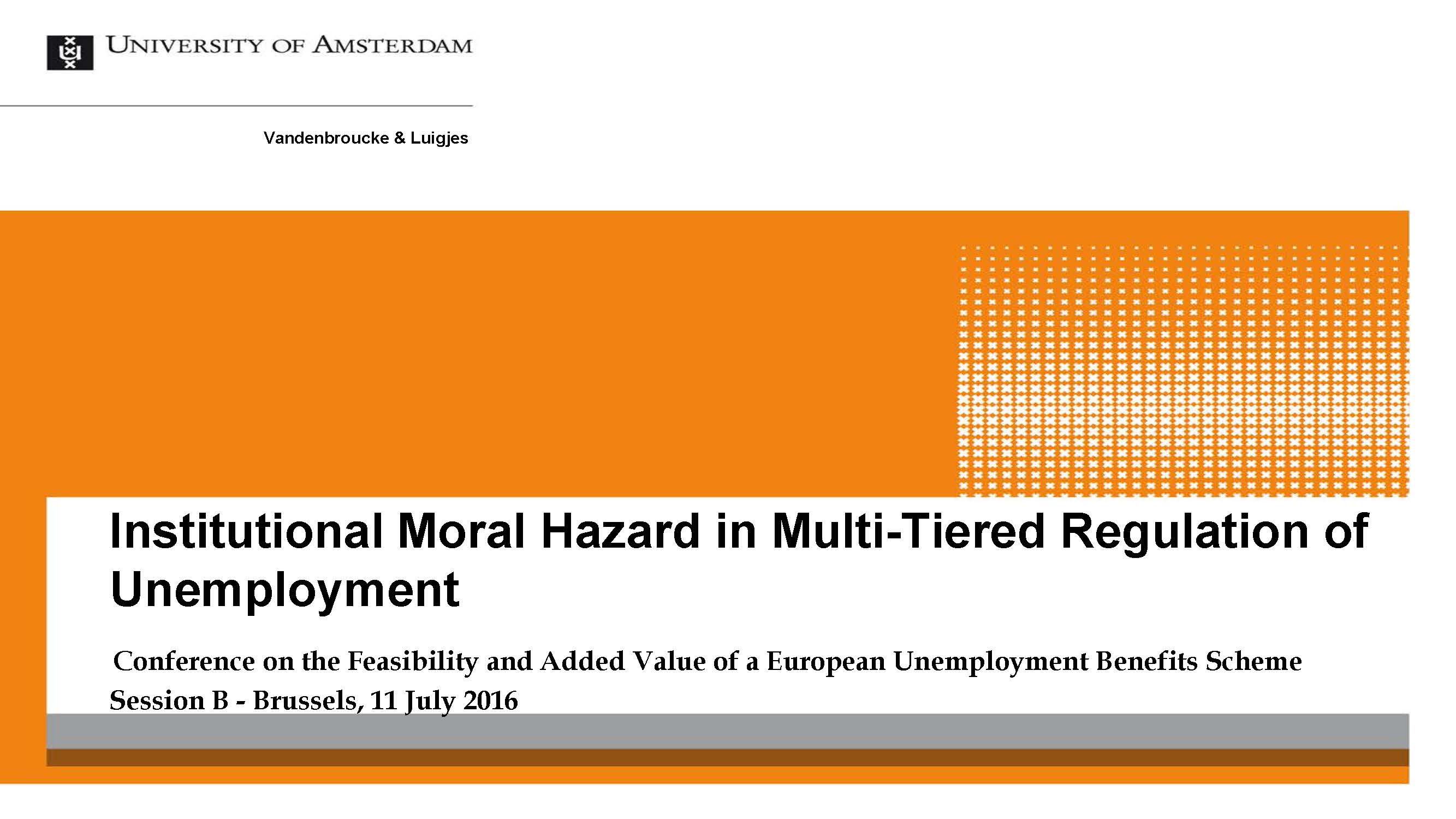 Download presentation
Download presentation
IMH_Luigjes-Vandenbroucke-11.7.2016
Institutional Moral Hazard in Multi-Tiered Regulation of
Unemployment
Conference on the Feasibility and Added Value of a European Unemployment Benefits Scheme
Session B – Brussels, 11 July 2016
Vandenbroucke & Luigjes
Introduction
Concept of ‘institutional moral hazard’ (IMH)
Caveats
Factors that contribute to its salience
(Concern for) IMH in the 8 cases
General & country specific
Conclusions
Minimum requirements
Institutional Moral Hazard in Multi-Tiered Regulation of
Unemployment
2
IMH: definition
A situation in which an insured person can affect the insured
company’s liability without its knowledge (Barr, 2004)
Two levels of government (A & B)
‘A’ covers a risk that ‘B’ could cover as well
Policies by ‘B’ influence incidence of the risk
Asymmetric information
Examples
Dumping, parking, creaming
Institutional Moral Hazard in Multi-Tiered Regulation of
Unemployment
3
IMH: caveats & nuances
Our focus: activation & interaction UI – SA
But, other factors influence the risk of unemployment
But, there is a broader fiscal context
IMH is inevitable in insurance
Danger of over-stressing and over-simplifying
Perceptions matter
Institutional Moral Hazard in Multi-Tiered Regulation of
Unemployment
4
IMH: factors that contribute to its salience
Design of schemes
Generosity for individuals, design of re-insurance, other fiscal mechanisms
Interaction with other components of the regulation of
unemployment
Activation policies, Social Assistance
Local or regional differences
Heterogeneity in employment rates, differences w.r.t. policy goals
Institutional Moral Hazard in Multi-Tiered Regulation of
Unemployment
5
IMH in 8 cases: general findings
Concern for IMH plays/played a role in every country case
However, the extent of (concern for) IMH differs
Dominant issues differ
Poor activation
Perverse interactions with other benefits (Social Assistance)
Heterogeneity between constituent parts of countries
Different views on policy goals
Reforms differ: centralisation vs decentralisation
Federal/central take-over, more federal/central control or less re-insurance
Institutional Moral Hazard in Multi-Tiered Regulation of
Unemployment
6
IMH in 8 cases: country specific findings (1)
US
UI: federal-state cooperation, FUTA, extended benefits
SA: move away from open-ended funding (AFDC) to block-grant (TANF)
GER, CHE, AUT
Common issue: problematic dichotomy SA and UI (also: dumping)
Different solutions: federal take-over, federal requirements, closing off UI
DNK
Reimbursement model
Institutional Moral Hazard in Multi-Tiered Regulation of
Unemployment
7
IMH in 8 cases: country specific findings (2)
CAN, BEL
‘Classic’ IMH: federal benefits, regional activation
Difference in salience of IMH in UI, different solutions
AUS
ALMPs privatised (no intergovernmental dimension)
Increasingly strict governmental control
Institutional Moral Hazard in Multi-Tiered Regulation of
Unemployment
8
Conclusions
IMH is inevitable
But it can be mitigated to a certain extent
Cost-benefit analysis is required
Complexity of national systems will be a challenge to EUBS
Institutional Moral Hazard in Multi-Tiered Regulation of
Unemployment
9
Conclusions: minimum requirements
Most likely candidate to mitigate IMH in EUBS: minimum
requirements
EUBS presupposes minimum requirements
Two purposes: optimising stabilisation & mitigating IMH
Minimum requirements best suited for heterogeneous constituent units
Less intensive than performance measurement
Stronger centralisation of regulation of unemployment is not an option
Allows diversity
Can build on a precedent in the EU: OMC
Institutional Moral Hazard in Multi-Tiered Regulation of
Unemployment
10
Sources
Barr, N. (2004), Economics of the Welfare State, New York:
Oxford University Press.
Institutional Moral Hazard in Multi-Tiered Regulation of
Unemployment
11
